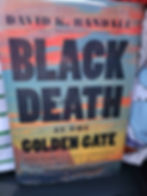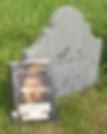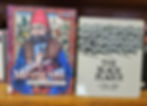"A Plague Upon Both Your Houses"
- Pangur's Teacup
- Jul 31
- 4 min read

A few years ago, an article online about a wild squirrel in Colorado with bubonic plague caught my eye. What?! I had thought that dreadful medieval disease had gone the way of smallpox, hopefully never to be seen again. A quick search of the internet confirmed that, unfortunately yes, there were a few cases reported every year in the United States. Although today, if caught early enough, the plague is completely curable. Today, it isn't so much the rats as it is the squirrels that you need to beware of.


Fast forward to late fall of 2023. I was looking for sources on the Black Plague at my local library, and came across the 2019 book Black Death at the Golden Gate: The Race to Save America from the Bubonic Plague by David K. Randall. My cursory research had never come across the narrow escape from this dreaded disease the United States had experienced in the late 19th and early 20th centuries. In many ways this book read like a thriller as early public health officials (Marine Hospital Service) in San Francisco not only had to race time in their efforts to stop the spread of the plague, but also mocking journalists, self-serving politicians who worried about more about potential economic losses than people’s deaths and rampant racism towards Chinese immigrants, as the disease first appeared in Chinatown. I found it especially ironic that attitudes towards health officials, vaccinations and quarantines have not changed a bit. Author Randall stated Americans in the late 1800s refused to send their children to school rather than have them inoculated against smallpox, and health officials found it hard to get people to take the real threat of a widespread bubonic plague epidemic seriously even when their neighbors were dying.

While the true cause of the death of William Shakespeare's son, Hamnet, is unknown, Maggie O'Farrell, in her historical novel entitled Hamnet, imagines it to have been the bubonic plague. I am not usually a fan of historical fiction, as I would rather read a biographical or historical account of actual people, this book was really well done. In her retelling, O'Farrell traces the disease's travels in a shipment of goods along with the rats and fleas from Italy. She imagines that both Hamnet and his twin sister, Judith, succumbed to the dreaded disease initially, but only Judith survived. Anne Hathaway's sorrow is particularly heartbreaking. On an interesting side note, Shakespeare's famous Sonnet 18, Shall I Compare Thee to a Summer's Day, may actually be about Hamnet.

Nothing in the library has a shorter shelf life than a children’s nonfiction book. This is a sad fact because nonfiction information can become outdated fast. Recently, I took out two books on medieval medicine from my library system. The first book, Dr. Medieval: Medicine in the Middle Ages, is a fairly recent publication from Scholastic. It is a slim volume designed for the younger reader, and is filled with colorful illustrations and short, concise text. Organized into two page spreads, the narrator is a medieval doctor discussing his cases and treatments on the first page followed by explanations and a “truth” bubble describing what was correct in medieval practices. In order to help the independent reader, there are two glossaries, one at the beginning of the book and one at the end. It was a quick, fun and informative read, but it only scratched the surface.

The second book, The Black Plague, is a slightly longer book clearly intended for a slightly older reader. Published in 1982, its drab cover will easily be overlooked unless one is actually looking for information on the bubonic plague, and nothing else is available. The black and white illustrations don’t help, nor its slightly stuffy writing style. Its unattractiveness is really unfortunate, because it is full of interesting and still relevant information regarding one of the worst pandemics ever experienced in European and even world history. I now know where the phrase “abracadabra” came from. Author Walter Oleksy is careful to include background explanations as well as place all information into a wider context. He includes quotations from primary sources such as Boccaccio’s Decameron, and assumes his juvenile audience can handle a frank but age-appropriate discussion of death, the breakdown of morals, racial targeting that resulted from the Black Death, and even modern threats to public safety due to pandemics and the possibility of germ warfare. I am still thinking about an interesting comment about the Dark Ages: “Though great poverty did exist in medieval Europe, and magic did compete strongly with religion, the Dark Ages refers more to the darkness of the mind and a general lack of interest in learning and the acquisition of new knowledge than to actual social conditions” (7). I sure hope someone takes this book out again and extends its shelf life for a little longer.

For such troubling, heavy topics such as the bubonic plague, a smooth, soothing tea is best. While chamomile is reputedly the most calming, I prefer mint any day, and despite all of the mint in my garden and green tea in my cupboard, I cannot replicate the Moroccan mint tea served at Teteria Al Sultan in Seville, Spain. Hot or cold, it just makes everything better. If mint is not to your taste, there are many other selections as well as other treats.

Artwork credited to Aurora Draws - contact aliceechesley@gmail.com for more details
All photographs by the author